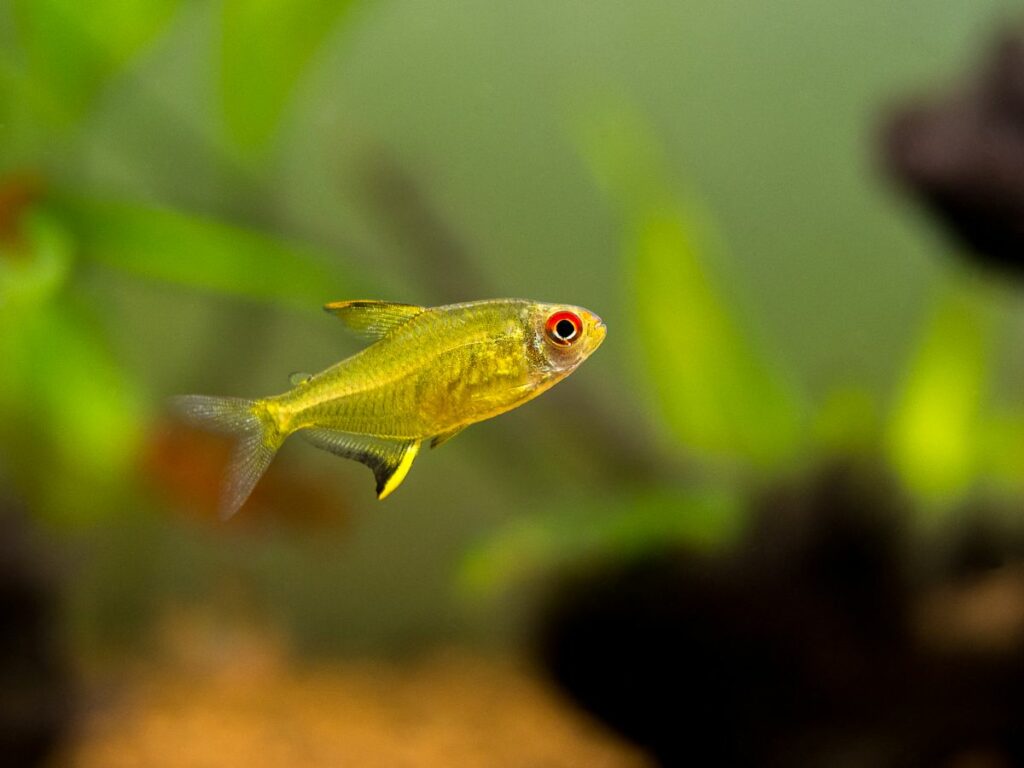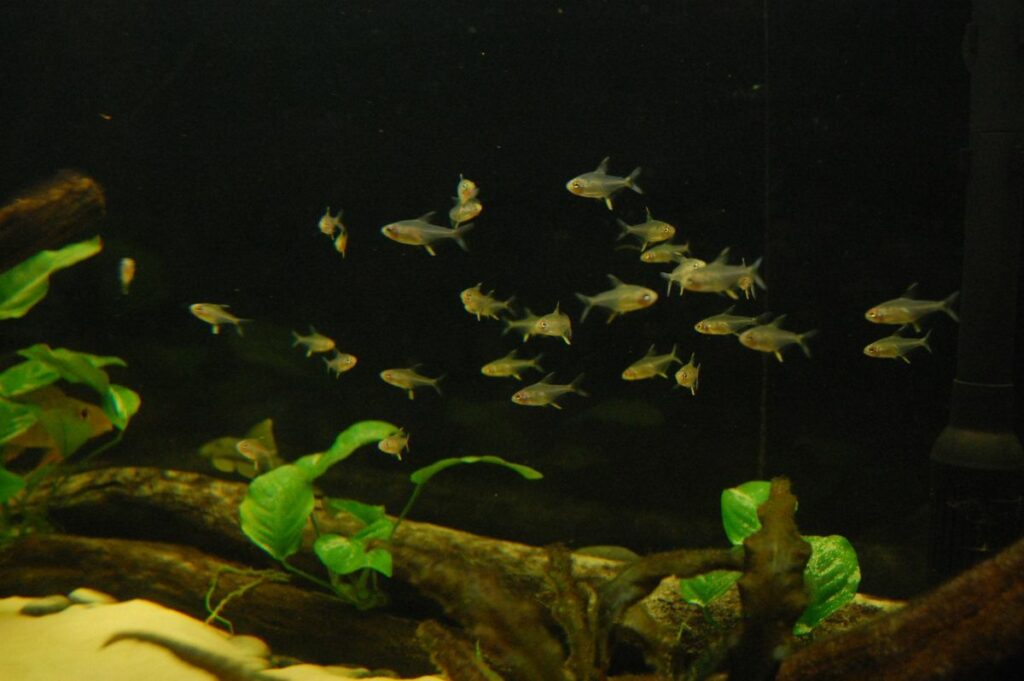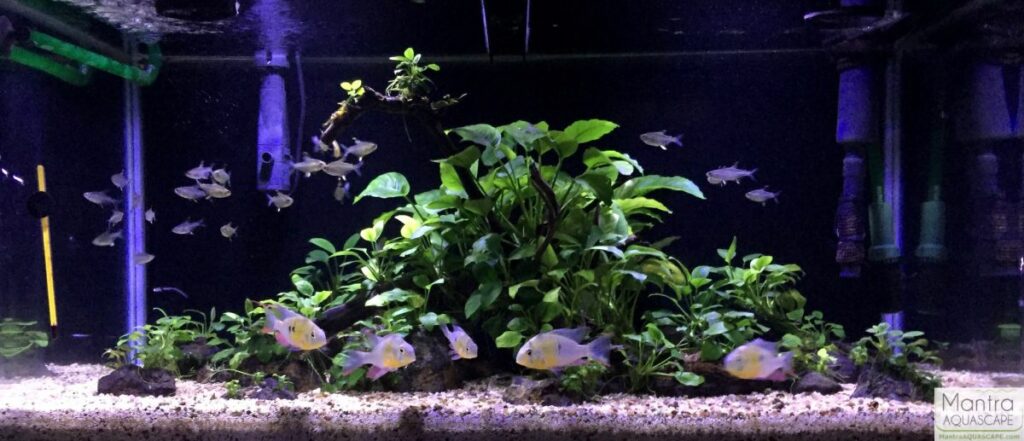Yellow is a rare color in wild-morph freshwater fish, making the lemon tetra a real showstopper. Small and peaceful, they will find a place in most community tanks. Since you’ve already decided to say yes to them, how do we care for a school of lemon tetras?

What is the Lemon Tetra?
Lemon tetras are found in the Tapajós River, a tributary of the Amazon. Their home range also extends into the main Amazon river basin but they are less common there. Many Amazonian fish are exclusive to one tributary river or even small streams.
Lemon tetras are members of the family Characidae; a huge family of fish found in North and South America. Several popular aquarium fish are from this group, including dozens of different tetra fish.
And of the group, lemon tetras are one of the oldest aquarium favorites. They first entered the trade in 1932, when the first surveys from Brazil were returning with neon tetras and other new additions.
Since their addition, a couple of morphs have entered the hobby. The albino lemon tetra is easier to find shopping online. It comes from fish farms in Thailand and has a ghost white appearance. The red eye paired with the lemon yellow anal fin is quite striking.
The second common morph is the long finned lemon tetra. Other than its finnage the colors are identical to the original fish.
- Common Name: Lemon Tetra
- Scientific Name: Hyphessobrycon pulchripinnis
- Origin: Tapajós River and Amazon River basin
- Length: 1½ inches
- Tank Size: 20 gallons
- Temperament: Peaceful; Schooling
- Ease of Care: Easy
Lemon Tetra Care
Lemon tetras, like all tetra fish, are a little more sensitive than livebearers and barbs to poor water quality. They are also harder to breed. Otherwise, they are excellent beginner fish for cycled aquariums.
Lemon Tetra Size
The full grown lemon tetra size is 1½ inches, with 1 inch being more common. These little fish are active, however. Plus they need the company of their own kind. A 20 gallon aquarium is the minimum tank size for lemon tetras.
When kept alone, tetras become stressed. They feel that the rest of their school is hiding from a predator or some other threat. The fish feel exposed and will hide most of the time.
Six fish is the minimum for any school of tetras, with more being better. In the wild, lemon tetras live in schools of thousands of fish.
More tetras also minimizes aggression since they will nip at each other to establish a pecking order. Nipped fins of subdominant fish may get infected by fin rot if not allowed to heal.
Setting Up a Tank for Lemon Tetras

Lemon tetra fish are great additions to a planted fish tank. The water conditions for a planted aquascape also happen to be ideal for tetras. Most tetra fish don’t eat plants, either.
Live plants also help define a biotope aquarium, where all of the organisms come from a single eco-region of the world. You could keep lemon tetras with Amazon sword plants, chain swords, Amazon frogbit, red root floater, and other species from South America.
If you don’t want to be strict, stick with aquarium plants that thrive in heat. Plants for discus tanks will do well alongside lemon tetras.
Gravel and sand are both good substrate choices for a lemon tetra tank. These fish are midwater swimmers. They don’t hang around near the bottom unless they see a bit of uneaten food. Choose a substrate that your plants will thrive in and matches the aesthetic you have in mind.
Rocks and driftwood are also good additions to the tank. Make sure you’re aware of the chemical properties of these items, however.
Rocks often contain calcium carbonate and other minerals that raise or lower the pH. Several types of driftwood are rich in tannins and humic acids, which lower the pH.
Lemon tetras prefer a low pH, so driftwood is a valuable addition to the tank. But limestone and other sedimentary rocks will counteract this, pushing the pH towards alkalinity.
Water Conditions for Lemon Tetras
Lemon tetras should be kept in neutral to acidic conditions (pH 5.5-7.0). With water hardness (dissolved mineral content) levels being moderate to low (5 to 15 dGH).
Since they have been tank raised for generations they will live for a long time in alkaline water (pH 7.0+). But their color and health will still suffer. And they won’t breed at all in these conditions.
Water temperature is also important for lemon tetras. They are equatorial tropical fish and need a range of 72-84℉ at all times. 76-82℉ is the ideal zone, with higher being perfect for spawning or helping them fight off diseases.
All tetra fish are sensitive to dissolved nitrogenous waste (ammonia, nitrite, nitrate). Not so sensitive that they are difficult to care for. But more sensitive than other beginner aquarium fish.
If your tank has measurable levels of ammonia or nitrite, get that under control before keeping lemon tetras. Otherwise they are likely to die. Water changes and fully cycling your tank will bring parameters down to healthy levels.
Best Food for Tetras
Tetra fish are almost all carnivorous and lemon tetras are no exception. They are micro predators, meaning they feed on any small animals they encounter in their habitat. Insect larvae, tiny shrimp, crustaceans, worms, fish eggs, and other small animals are what they eat.
Tetra food needs to be rich in high quality animal protein. Lemon tetras are all tank raised so they accept flakes and micro pellets, no problem. Just make sure the formula you choose has animal protein as the first few ingredients.
Cheaper blends use potato powder, wheat starch, and other cheap factory farm fillers. Fine for omnivores like goldfish and guppies but not suitable for lemon tetras. If you want to try breeding lemon tetras then protein becomes even more important.
Include live and/or frozen food as well in their diet. Bloodworms and brine shrimp are easy to find at most pet stores. Brine shrimp has healthy fats to add to their diet. And both foods are rich in color enhancing carotenoid pigments.
Live tubifex worms are even higher in fat; perfect for conditioning female fish to produce eggs. That said, don’t offer tubifex worms every day since too much fat is bad for all fish.
Lemon Tetra Tank Mates

Lemon tetras are excellent community tank residents. They are peaceful, schooling fish that keep to themselves. Any tank mates should also be peaceful to avoid stressing these fish.
The list of suitable tank mates is long. Here are a few options to consider pairing them with:
- Other Tetra fish
- Dwarf Gouramis
- Cory Catfish
- Killifish
- Blue Rams and other Dwarf Cichlids
- Dwarf Otocinclus
- Kuhli Loaches
- Danios
- Bristlenose Plecos
Avoid predatory, aggressive, and territorial species. Dwarf cichlids are sometimes territorial but won’t cause too much stress. As long as you have a spacious tank (30+ gallons) the tetras will be fine with them.
The fish on this list also thrive in the same neutral to slightly acidic conditions that lemon tetras do. Livebearers like platies and guppies are a good match for lemon tetras in terms of temperament. But they prefer hard, alkaline water conditions.
Breeding Lemon Tetras
Once you’ve mastered keeping lemon tetras alive, you might be thinking of breeding them. Tetra fish are not easy to breed. But it’s possible even for beginners to achieve.
Lemon Tetra Male vs Female
Sexing tetra fish is not easy to do. Other than the females being a little thicker they tend to look identical to each other. You’ll have an easier time with lemon tetras, however.
Male lemon tetra fish have a thicker black border along their anal fin. The dark area may cover a third of the fin’s total area in males that are ready to breed. In female lemon tetras, the black line is thin at all times.
Lemon Tetra Spawning
Lemon tetras often spawn when kept in planted aquariums. They are egg scatterers, meaning the parents provide no care for their eggs or fry. At dawn or dusk they dark into thickets of aquatic plants. They then scatter sticky eggs around in bursts before abandoning them.
Tetra fish will eat their eggs a few hours after laying them. So you need to be proactive in gathering them once you see the female is no longer swollen. They will spawn several times per year. So even if you miss one batch of eggs, another will be on the way.
You should remove any plants with eggs attached to a fry rearing aquarium. Breeders often use spawning mops, which look like live plants but are easy to install and remove. Spawning mops also don’t need lights or fertilizer.
Lemon tetra eggs hatch in 24 hours and the fry are free swimming 5 days after hatching. They are tiny and eat infusoria at first.
Infusoria are planktonic freshwater organisms like paramecium and amoeba. They are easy to raise beforehand for feeding your baby lemon tetras. By the eighth day they will be large enough to eat live baby brine shrimp nauplii.
Conclusion
The lemon tetra is a great schooling fish for most community tanks. They do need good water quality but nothing beyond a well informed beginner’s abilities. Tetra fish are challenging to breed but well worth the effort.
FAQs
Lemon tetras may nip fins but they are one of the more peaceful tetras. I would even keep them with bettas and other long finned fish. Black skirt tetras, Mexican tetras, and other larger tetra species are much more prone to fin nipping than lemon tetras.
Lemon tetras live in schools of thousands of fish in the wild. More is always better when buying tetra fish. Don’t buy less than six of them or they will be stressed.

